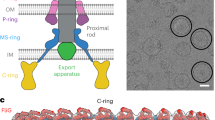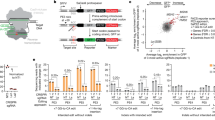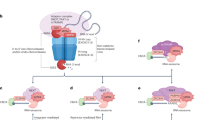Abstract
Translation initiation is a major determinant of the overall expression level of a gene1,2,3. The translation of functionally active protein requires the messenger RNA to be positioned on the ribosome such that the start/initiation codon will be read first and in the correct frame. Little is known about the molecular basis for the interaction of mRNA with the ribosome at different states of translation. Recent crystal structures of the ribosomal subunits4,5,6,7,8, the empty 70S ribosome9 and the 70S ribosome containing functional ligands10,11,12,13 have provided information about the general organization of the ribosome and its functional centres. Here we compare the X-ray structures of eight ribosome complexes modelling the translation initiation, post-initiation and elongation states. In the initiation and post-initiation complexes, the presence of the Shine–Dalgarno (SD) duplex causes strong anchoring of the 5′-end of mRNA onto the platform of the 30S subunit, with numerous interactions between mRNA and the ribosome. Conversely, the 5′ end of the ‘elongator’ mRNA lacking SD interactions is flexible, suggesting a different exit path for mRNA during elongation. After the initiation of translation, but while an SD interaction is still present, mRNA moves in the 3′→5′ direction with simultaneous clockwise rotation and lengthening of the SD duplex, bringing it into contact with ribosomal protein S2.
This is a preview of subscription content, access via your institution
Access options
Subscribe to this journal
Receive 51 print issues and online access
$199.00 per year
only $3.90 per issue
Buy this article
- Purchase on Springer Link
- Instant access to full article PDF
Prices may be subject to local taxes which are calculated during checkout



Similar content being viewed by others
References
Gold, L. Posttranscriptional regulatory mechanisms in Escherichia coli.. Annu. Rev. Biochem. 57, 199–233 (1988)
Draper, D. E. in Escherichia coli and Salmonella: Cellular and Molecular Biology 2nd edn (eds Neidhardt, F. C. et al.) 902–908 (ASM Press, Washington, DC, 1996)
Kozak, M. Regulation of translation via mRNA structure in prokaryotes and eukaryotes. Gene 361, 13–37 (2005)
Wimberly, B. T. et al. Structure of the 30S ribosomal subunit. Nature 407, 327–339 (2000)
Ogle, J. M. et al. Recognition of cognate transfer RNA by the 30S ribosomal subunit. Science 292, 897–902 (2001)
Ban, N. et al. The complete atomic structure of the large ribosomal subunit at 2.4 Å resolution. Science 289, 905–920 (2000)
Schluenzen, F. et al. Structure of functionally activated small ribosomal subunit at 3.3 Å resolution. Cell 102, 615–623 (2000)
Harms, J. et al. High resolution structure of the large ribosomal subunit from a mesophilic eubacterium. Cell 107, 679–688 (2001)
Schuwirth, B. S. et al. Structures of the bacterial ribosome at 3.5 Å resolution. Science 310, 827–834 (2005)
Yusupov, M. M. et al. Crystal structure of the ribosome at 5.5 Å resolution. Science 292, 883–896 (2001)
Yusupova, G. Z. et al. The path of messenger RNA through the ribosome. Cell 106, 233–241 (2001)
Jenner, L. et al. Translational operator of mRNA on the ribosome: how repressor proteins exclude ribosome binding. Science 308, 120–123 (2005)
Petry, S. et al. Crystal structures of the ribosome in complex with release factors RF1 and RF2 bound to a cognate stop codon. Cell 123, 1255–1266 (2005)
Schurr, T., Nadir, E. & Margalit, H. Identification and characterization of E. coli ribosomal binding sites by free energy computation. Nucleic Acids Res. 21, 4019–4023 (1993)
Ringquist, S. et al. Translation initiation in Escherichia coli: sequences within the ribosome-binding site. Mol. Microbiol. 6, 1219–1229 (1992)
Ma, J., Campbell, A. & Karlin, S. Correlations between Shine–Dalgarno sequences and gene features such as predicted expression levels and operon structures. J. Bacteriol. 184, 5733–5745 (2002)
La Teana, A., Gualerzi, C. O. & Brimacombe, R. From stand-by to decoding site. Adjustment of the mRNA on the 30S ribosomal subunit under the influence of the initiation factors. RNA 1, 772–782 (1995)
Rinke-Appel, J. et al. Contacts between 16S ribosomal RNA and mRNA, within the spacer region separating the AUG initiator codon and the Shine–Dalgarno sequence; a site-directed cross-linking study. Nucleic Acids Res. 22, 3018–3025 (1994)
Canonaco, M. A., Gualerzi, C. O. & Pon, C. L. Alternative occupancy of a dual ribosomal binding site by mRNA affected by translation initiation factors. Eur. J. Biochem. 182, 501–506 (1989)
Cate, J., Yusupov, M., Yusupova, G., Earnest, T. & Noller, H. X-ray crystal structures of 70S ribosome functional complexes. Science 285, 2095–2104 (1999)
Otwinowski, Z. & Minor, W. Processing of X-ray diffraction data collected in oscillation mode. Methods Enzymol. 276, 307–326 (1997)
Brünger, A. T. et al. Crystallography & NMR system: A new software suite for macromolecular structure determination. Acta Crystallogr. D 54, 905–921 (1998)
Rees, B., Jenner, L. & Yusupov, M. Bulk-solvent correction in large macromolecular structures. Acta Crystallogr. D 61, 1299–1301 (2005)
Jones, T. A., Zou, J. Y., Cowan, S. W. & Kjeldgaard, M. Improved methods for building protein models in electron density maps and the location of errors in these models. Acta Crystallogr. A 47, 110–119 (1991)
DeLano, W. L. The PyMOL Molecular Graphics System (DeLano Scientific, San Carlos, California, 2002)
Acknowledgements
We thank C. Schulze-Briese and the SLS staff for help with X-ray data collection. This work was funded by CNRS and INSERM. Author Contributions G.Y. and L.J. contributed equally to this work. G.Y. performed the biochemical experiments and crystallized the ribosome complexes. L.J. solved the structures. All authors participated in discussing the results and writing the manuscript.
Author information
Authors and Affiliations
Corresponding author
Ethics declarations
Competing interests
Coordinates and structure factors have been deposited in the Protein Data Bank under accession numbers 2HGR and 2HGU (initiation complex 30S and 50S subunits), 2HGP and 2HGQ (post-initiation complex) and 2HGI and 2HGJ (mRNA-free complex). Reprints and permissions information is available at www.nature.com/reprints. The authors declare no competing financial interests.
Supplementary information
Supplementary Notes
This file contains Supplementary Methods, Supplementary Results, Supplementary Figures and Supplementary Tables. (DOC 563 kb)
Rights and permissions
About this article
Cite this article
Yusupova, G., Jenner, L., Rees, B. et al. Structural basis for messenger RNA movement on the ribosome. Nature 444, 391–394 (2006). https://doi.org/10.1038/nature05281
Received:
Accepted:
Published:
Issue Date:
DOI: https://doi.org/10.1038/nature05281
This article is cited by
-
Annotating Macromolecular Complexes in the Protein Data Bank: Improving the FAIRness of Structure Data
Scientific Data (2023)
-
Specific length and structure rather than high thermodynamic stability enable regulatory mRNA stem-loops to pause translation
Nature Communications (2022)
-
Cryo-EM study of an archaeal 30S initiation complex gives insights into evolution of translation initiation
Communications Biology (2020)
-
ArfB can displace mRNA to rescue stalled ribosomes
Nature Communications (2020)
-
Strategies for enhancing gene expression in Escherichia coli
Applied Microbiology and Biotechnology (2020)
Comments
By submitting a comment you agree to abide by our Terms and Community Guidelines. If you find something abusive or that does not comply with our terms or guidelines please flag it as inappropriate.



